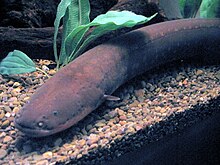Naked-back knifefish
| Naked-back knifefishes | |
|---|---|

| |
| Electric eel, Electrophorus electricus | |
| Scientific classification | |
| Kingdom: | Animalia |
| Phylum: | Chordata |
| Class: | Actinopterygii |
| Order: | Gymnotiformes |
| Suborder: | |
| Family: | Gymnotidae |
The naked-back knifefishes are a family (Gymnotidae) of knifefishes found only in fresh waters of Central America and South America.[1] All have organs adapted to the exploitation of bioelectricity. The family has about 40 valid species in two genera.[1] These fish are nocturnal and mostly occur in quiet waters from deep rivers to swamps. In strongly flowing waters, they may bury themselves.[1]
Physical characteristics[]
Like the other gymnotiforms, gymnotids have classic knifefish bodies. The body is long and eel-like, the dorsal fin and pelvic fins are absent, and the anal fin is extremely long and used for movement.[1]
The sole member of Electrophorus is the electric eel, which produces both strong (up to 600 volts) and weak (<1 V) electric discharges, for use in predation and communication/navigation, respectively. The electric eel is the largest of the gymnotiform fishes, growing up to more than 2 m (6.6 ft) length. Species of Gymnotus range from about 10–100 cm (0.3–3.3 ft) in total length.[2][3]
These knife fishes also use electricity to assist in their movement and navigation in the water due to their limited vision.[4]
Genera[]
According to FishBase, there are 40 species in two genera,[1] but this does not include 4 new species described in 2016–2018.[5][6][7]
- Electrophorus (3 species)
- Gymnotus (43 species)
Historically, Electrophorus was in a separate family Electrophoridae and ITIS continues to do this,[8] but this is contradicted by available evidence and not followed by other authorities.[1][3][9][10]
References[]
- ^ Jump up to: a b c d e f Froese, Rainer, and Daniel Pauly, eds. (2007). "Gymnotidae" in FishBase. April 2007 version.
- ^ Nelson, Joseph, S. (2006). Fishes of the World. John Wiley & Sons, Inc. ISBN 0-471-25031-7.
- ^ Jump up to: a b van der Sleen, P.; J.S. Albert, eds. (2017). Field Guide to the Fishes of the Amazon, Orinoco, and Guianas. Princeton University Press. pp. 330–334. ISBN 978-0691170749.
- ^ "Archived copy". Archived from the original on 2013-06-03. Retrieved 2012-03-16.CS1 maint: archived copy as title (link)
- ^ Giora, J.; L.R. Malabarba (2016). "Gymnotus refugio, a new and endangered species of electric fish of the Gymnotus pantherinus species-group from southern Brazil (Gymnotiformes: Gymnotidae)". Zootaxa. 4066 (5): 581–590. doi:10.11646/zootaxa.4066.5.6. PMID 27395856.
- ^ Craig, J.M.; V. Correa-Roldán; H. Ortega; W.G.R. Crampton; J.S. Albert (2018). "Revision of Gymnotus (Gymnotiformes: Gymnotidae) from the Upper Madeira Basin of Bolivia and Peru, with descriptions of two new species". Zootaxa. 4413 (1): 111–132. doi:10.11646/zootaxa.4413.1.3.
- ^ Craig, J.M.; L.R. Malabarba; W.G.R. Crampton; J.S. Albert (2018). "Revision of banded knifefishes of the Gymnotus carapo and G. tigre clades (Gymnotidae Gymnotiformes) from the Southern Neotropics". Zootaxa. 4379 (1): 47–73. doi:10.11646/zootaxa.4379.1.3.
- ^ "Electrophoridae". ITIS. Retrieved 2016-10-11.
- ^ Ferraris Jr, C.J.; C.D. de Santana; R.P. Vari (2017). "Checklist of Gymnotiformes (Osteichthyes: Ostariophysi) and catalogue of primary types". Neotrop. Ichthyol. 15 (1). doi:10.1590/1982-0224-20160067.
- ^ Eschmeyer, W.N.; R. Fricke; R. van der Laan (12 May 2018). "Catalog of Fishes". California Academy of Sciences. Retrieved 12 May 2018.
- Gymnotidae
- Electric fish
- Fish of South America
- Fish of Central America
